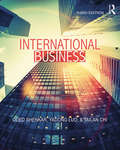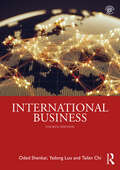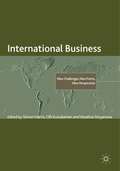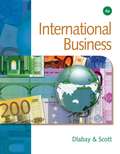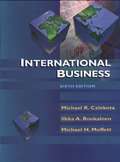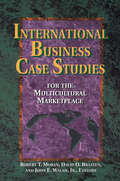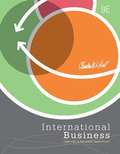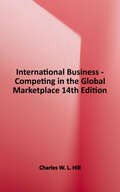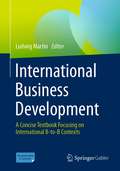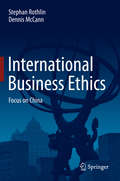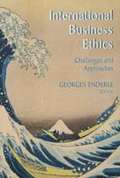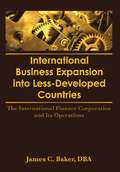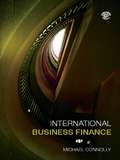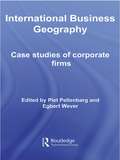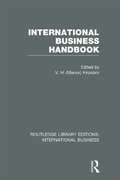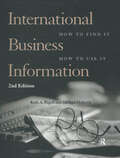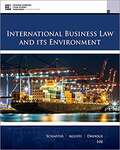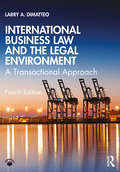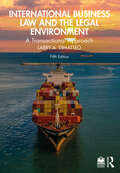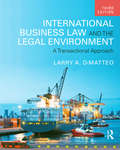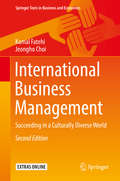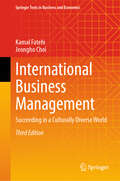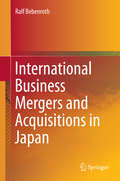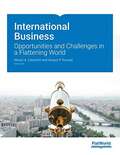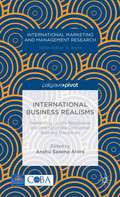- Table View
- List View
International Business
by Oded Shenkar Yadong Luo Tailan ChiThe third edition of International Business offers an action-focused, practical approach to the topic, helping students understand the global business environment and its repercussions for executives. The book provides thorough coverage of the field, delving into fundamental concepts and theory; the cultural, political, and economic environment; international business strategies; and even functional management areas. More comprehensive than competing books, International Business includes: Strengthened, expanded global cases, examples, and 'industry' and 'country' mini-cases that give students practical insight into the ways companies actually behave within a competitive, global environment Updated coverage of key trends that impact how international business functions, including the drivers of globalization, e-commerce and the impact of the Internet, and international entrepreneurship New material on technology issues, the impact of the financial crisis, and problems in the EU Expanded discussion of the skills and strategies students need to succeed in today's international business environment, including dynamic capabilities, foreign direct investment, and market entry strategies Also featuring a companion website with a test bank, Powerpoint slides, and instructor’s manual, this book is ideal for undergraduate and graduate students and instructors of any international business course.
International Business
by Oded Shenkar Yadong Luo Tailan ChiThis fully revised and updated fourth edition of International Business offers an action- focused, practical approach to the topic, helping students understand the global business environment and its repercussions for executives. The book provides thorough coverage, delving into fundamental concepts and theory; the cultural, political, and economic environment; international business strategies; and even functional management areas. More comprehensive than competing books, this new edition of International Business includes: A new chapter on the digitalization of the global economy and its implications for firm strategy and organizations. New examinations of the forces of de- globalization, implications of rising trade protectionism, challenges of geopolitical conflicts, and a friction framework for understanding the effects of cultural differences. Enriched and expanded discussions about potential reconfigurations of global value chains following the COVID- 19 pandemic, changing perspectives on the role of the government with renewed attention to industrial policy, shifts in regional integration with the emergence of such new trade blocks as CPTPP and RCEP, and fresh insights on factors influencing a country’s balance of payments. Strengthened, expanded global cases, examples, and “industry” and “country” mini- cases that give students practical insight into the ways companies actually behave within a competitive, global environment. Also featuring a companion website with a test bank, PowerPoint slides, and instructor’s manual, this book is ideal for students and instructors of any international business course at undergraduate or postgraduate level.
International Business
by Simon Harris Olli Kuivalainen Veselina StoyanovaProvides an in-depth analysis of some of the most recent challenges for international businesses, such as corporate social responsibility and the phenomenon of outward foreign direct investment from China. Reflects on the new perspectives in international business by presenting the experience of successful business experts in the field.
International Business (4th Edition)
by Les Dlabay James Calvert ScottInternational Business 4E provides students with the attitudes, knowledge, and skills for entry-level international business and marketing occupations. Content includes political, legal, financial, economic and social/cultural considerations. Students will be able to understand and compare the way in which business and marketing is conducted domestically versus internationally. The text covers real-world applications, projects, technology, ethics, and cross-curricular links. Students will find the communication sections particularly useful in helping them prepare international communication and trade documentation. The technology coverage from a global perspective helps students research and prepare interactive multimedia presentations.
International Business (Sixth Edition)
by Michael H. Moffett Ilkka A. Ronkainen Michael R. CzinkotaThis text addresses itself to the issues involved in doing business abroad. It includes theory and research, some basic geography and culture, suggestions for even the small companies to use technology to reach other countries, and more.
International Business Case Studies For the Multicultural Marketplace (Managing Cultural Differences Ser.)
by Robert T. Moran David O. Braaten Ph.D. John Walsh, D.B.A.This comprehensive guide presents specific, real-life examples of the strategies and tactics used by some of the world's most successful international businesses and organizations to excel in the global marketplace. Divided into six major sections, this important book features more than 30 case studies that span critical issues of international business--globalization; negotiation; marketing; product/service quality; joint ventures and strategic alliances; and culturally diverse workforces. Each case study focuses on a particular company, region, or management style to clearly illustrate proven techniques for capitalizing on the cultural diversity of people, products, and markets. With contributions from more than two dozen business executives and professors, spanning the globe from Japan, to Germany, China to Mexico, this casebook provides a broad spectrum of current and future approaches to acheiving international and cross-cultural business success.
International Business Competing in the Global Marketplace (Ninth Edition)
by Charles W. L. HillMarket-defining since it was introduced, International Business: Competing in the Global Marketplace by Charles W. L. Hill, sets the standard. Hill draws upon his experience to deliver a complete solution-print and digital―for instructors & students by being: Integrated - Progression of Topics Application Rich - Strong on Strategy Current - Thought Provoking Relevant - Actual Practice of International Business
International Business Competing in the Global Marketplace, 14th Edition
by Charles W. L. HillMarket-defining since it was introduced, International Business: Competing in the Global Marketplace by Charles W.L. Hill (University of Washington) sets the standard and is the proven choice for International Business at the undergraduate and graduate levels. The 14th edition provides a complete solution that is relevant (timely, comprehensive), practical (focus on applications of concepts), integrated (integrated progression of topics) and the most up-to-date on the market.
International Business Development: A Concise Textbook Focusing on International B-to-B Contexts
by Ludwig MartinThis textbook offers theories, terminology, common approaches and current issues in international business development. It covers the full range from strategic considerations to setting up supply chains and sales channels in a globalized world. In addition, a closer look into issues of social responsibility and cultural aspects of international business is presented. A particular feature is the focus on Business to Business contexts of international management. The authors with their varied backgrounds from academia as well as industry offer insights into topics such as (frugal) innovation, legal aspects of launching products internationally, ecosystem evaluations, market assessments, political coverage for international ventures, project management standards, sales approaches as well as digital communication. Case studies illustrate the theoretical content. Early career practitioners will find this book to be a good resource.This textbook has been recommended and developed for university courses in Germany, Austria and Switzerland.
International Business Ethics
by Stephan Rothlin Dennis MccannThis book addresses an essential need felt by many who seek to promote best business practices in China and East Asia - namely the need for culturally appropriate instructional materials (basic information, case studies and ethical perspectives) that will allow managers and entrepreneurs to understand and embrace the challenge of moral leadership in business. In an era characterized by globalization and the increasing importance of the economies of China, India, Japan and SE Asia, international business ethics must reflect the concerns of the people living and working in this area, the moral and spiritual traditions that have nurtured them and their specific contributions to sustainable development. This book presents twenty important case studies, taken from newsworthy events of the past few years, in which Asians and others have attempted to respond to this challenge. Each case study has been selected and shaped in order to highlight various aspects of doing business in Asia, starting with basic principles and moving on to the specific responsibilities that businesses have towards their various stakeholders. The authors contend that the best way to appreciate the relevance of Asian moral and spiritual traditions is to determine their specific contribution to virtue ethics, where the ancient traditions of both East and West converge in their focus on the qualities of moral leadership that form the basis of best business practice. Exploring the case studies will enable readers to appreciate the continued relevance of these ethical perspectives in Asian business. Best business practice clearly involves learning to do business and playing the game according to the rules; but the necessity of playing by the rules is not likely to become clear until one takes up the path that leads to a virtuous life in business, developing a moral character chiefly based on integrity.
International Business Ethics: Challenges and Approaches
by Georges Enderle<P>International Business Ethics: Challenges and Approaches, edited by Georges Enderle, is a pioneer in this widely uncharted field of international business ethics. <P>This volume includes the work of 39 contributors, half of them from non-Western countries, first presented at the First World Congress of Business, Economics, and Ethics hosted by Reitaku University and the Institute of Moralogy in Japan. <P>Together, their articles paint an extraordinarily rich multidisciplinary picture of international business ethics as it evolves, and delineate the contours of how international business ethics may develop at the turn of the millennium.
International Business Expansion Into Less-Developed Countries: The International Finance Corporation and Its Operations
by Erdener Kaynak James C BakerFor the first time, here is the complete history of the International Finance Corporation (IFC). In the fifty years since the end of World War II, the world of development finance has grown rapidly. One of the many financial institutions which cropped up to help war-torn countries with their reconstruction was the IFC. International Business Expansion Into Less-Developed Countries examines the success of the IFC in its wide variety of public sector development activities. Covering thirty-five years of IFC operations, the book thoroughly evaluates the formulation of the concept of the IFC and its evolution as a viable global development finance agency. It is the most complete and up-to-date treatment available of the IFC.The administration and operational procedures are described in detail as are case examples of financial development in all regions. Problems encountered by the IFC and new and future activities of the IFC are discussed. Scholars of economic development and international finance will find the unusual way in which the IFC was established and the case examples presented a highly valuable reference, as will students of international studies and organizations.
International Business Finance
by Michael ConnollyThis textbook introduces students to the fundamental workings of business and finance in the global economy. It brings clarity and focus to the complexities of the field and demonstrates the key linkages between the foreign exchange markets and world money markets. Core topics examined include: corporate aspects of international finance, with special attention given to contractual and operational hedging techniques the mechanics of the foreign exchange markets the building blocks of international finance the optimal portfolio in an international setting. Michael Connolly also provides up-to-date statistics from across the globe, relevant international case studies, problem sets and solutions and links to an online PowerPoint presentation. International Business Finance is an engaging and stimulating text for students in undergraduate and MBA courses in international finance and a key resource for lecturers.
International Business Geography: Case Studies of Corporate Firms (Routledge Studies In International Business And The World Economy Ser.)
by Egbert Wever Piet PellenbargWritten by eminent scholars who are well known within their fields across Europe, this book explores changes in the international economic environment, their impacts on the strategy of firms and the spatial consequences of these changes in strategy.The economic environment in which major companies operate is subject to rapid and important changes.
International Business Handbook: Improving Sme Performance Globally (Routledge Library Editions: International Business)
by V. H. Manek KirpalaniThe focus of the book is understanding international influences that affect international business, and relevant aspects of the world environment. These aspects are economic, physical, sociocultural, political, legal and technological and include the cultures of foreign business organizations. Each chapter is written by an expert in the field who has been involved in international business in that area. The purpose of each chapter is to enable effective performance in the international business arena. An integrated system view of the country or region and how managers can obtain success in that area is provided. Global in its coverage this book provides information on global trends, different regions and their consumer cultures and business customs, as well as methods of entry and global strategies.
International Business Information: How to Find It, How to Use It
by Michael Halperin Ruth A. PagellThis newly updated and expanded edition of a reference bestseller is the only work available that guides business researchers and librarians to the most valuable sources for information on international business--and shows how to interpret and use that data. The authors discuss the best available resources and how to use them to find answers to a wide range of questions about international business. They also describe business practices in various regions and countries, the basics of international trade and finance, international business organizations, and relevant political departments and agencies. Many exhibits and tables are included, and the book's appendices include glossaries, checklists for evaluating sources, and sample disclosure documents.
International Business Law and Its Environment: Tenth Edition (Mindtap Course List Series)
by Lucien Dhooge Richard Schaffer Filiberto Agusti<p>Today, no business is purely domestic. Even the smallest local firms are affected by global competition and world events. INTERNATIONAL BUSINESS LAW AND ITS ENVIRONMENT, 10E delivers complete, reader-friendly coverage of the legal implications and ramifications of doing business internationally. You examine the cultural, political, economic, and ethical issues today's global business managers face. With a focus on trade, the licensing of intellectual property, and foreign direct investment, you examine the three major forms of doing business in a foreign country. Real examples, precedent-setting cases, managerial implications, and ethical considerations show how to apply key principles. From the legal relationship between parties in an international business transaction to managing risk to the special challenges of conducting business in emerging economies, this edition helps you understand the most common practices and critical issues in global business law.</p>
International Business Law and the Legal Environment: A Transactional Approach
by Larry A. DiMatteoThe fourth edition of International Business Law and the Legal Environment: A Transactional Approach gives business and law students a clear understanding of the legal principles that govern international business. This book goes beyond compliance by emphasizing how to use the law to create value and competitive advantage. DiMatteo’s transactional approach walks students through key business transactions—from import and export, contracts, and finance to countertrade, dispute resolution, licensing, and more—giving them both context and providing real-world applications. More concise than previous editions, this new edition also features: • Added coverage of new technologies, such as smart contracts, digital platforms, and blockchain technology • Discussion of businesses and sustainability, climate change, and creating a circular economy • Greater focus on UNIDROIT Principles and a review of INCOTERMS 2020 • Expansion of common carrier coverage to include CMI trucking and CMR railway conventions • International perspective and use of a variety of national and international law materials • Great coverage of EU substantive law Upper-level undergraduate and postgraduate students of business law and international business will appreciate DiMatteo’s lucid writing style, and professionals will find this book to be a comprehensive resource. Online resources include an instructor’s manual, PowerPoint slides, test bank, and other tools to provide additional support for students and instructors.
International Business Law and the Legal Environment: A Transactional Approach
by Larry A. DiMatteoThe fifth edition of International Business Law and the Legal Environment: A Transactional Approach gives business and law students a clear understanding of the legal principles that govern international business. This book goes beyond compliance by emphasizing how to use the law to create value and competitive advantage.DiMatteo’s transactional approach walks students through key business transactions—from import and export, contracts, and finance to countertrade, dispute resolution, licensing, and more—giving them both context and providing real-world applications. This new edition also features:● Added coverage of new technologies, such as smart contracts, digital platforms, and blockchain technology, artificial intelligence, market for non-fungible tokens, and the metaverse● Discussion of businesses and sustainability, climate change, and creating a circular economy● International perspective and use of a variety of national and international law materials● Greater coverage of EU substantive law including the new Artificial Intelligence Act.Upper-level undergraduate and postgraduate students of business law and international business will appreciate DiMatteo’s lucid writing style, and professionals will find this book to be a comprehensive resource. Online resources include an instructor’s manual, PowerPoint slides, and test bank.
International Business Law and the Legal Environment: A Transactional Approach
by Larry A. DimatteoInternational Business Law and the Legal Environment provides business students with a strong understanding of the legal principles that govern doing business internationally. Not merely about compliance, this book emphasizes how to use the law to create value and competitive advantage. DiMatteo’s transactional approach walks students through key business transactions—from import and export, contracts, and finance to countertrade, dispute resolution, licensing, and more—giving them both context and demonstrating real world application. This new edition also includes: New material on comparative contract and sales law & European private law; joint ventures and collaborative alliances. A new part on foreign direct investment that includes a chapter on emerging markets. New chapters on privacy law, and on environmental concerns. Greater coverage of the World Trade Organization. "Case highlights" and court opinions that feature edited court transcripts which expose students to actual legal reasoning and an understanding of the underlying legal principles. These decisions are drawn from a broad range of countries, offering a truly international look at the subject. Students of business law and international business courses will find DiMatteo’s clear writing style easy to follow. A companion web site includes an instructor’s manual, PowerPoints, and other tools to provide additional support for students and instructors.
International Business Management: Succeeding in a Culturally Diverse World (Springer Texts in Business and Economics)
by Kamal Fatehi Jeongho ChoiThis textbook explores the theoretical and practical aspects of managing international business operations while also dealing with multi-cultural, multi-national and global issues of managing business expansion beyond the domestic market. A second, revised edition of Managing Internationally: Succeeding in a Culturally Diverse World, each chapter contains up-to-date material, in-depth coverage of topics, visual aids (i.e., charts, tables, etc.), and vignettes, making this new edition engaging, visually appealing and easily accessible for students taking International Business Management courses. The contents of this textbook are separated into four parts. Part one offers introductory information on the scope and importance of international business management as well as the social and ethical challenges. Part two covers cultural and behavioral topics. Part three discusses the strategic and operational aspects of international business management. Part four explores human resources and labor relations. To assist students, each chapter starts a preview section which includes an outline of the chapter indicating the important aspects along with a brief description of the major issues. Following the preview is a vignette that encapsulates the crux of the chapter, often presented in an amusing and engaging manner. To further help students focus on key issues, the text includes the list of useful business cases to which students can refer. To assist professors in teaching from this book, ancillary teaching materials such as sample syllabi, slides, tests and answer keys will be available for download.
International Business Management: Succeeding in a Culturally Diverse World (Springer Texts in Business and Economics)
by Kamal Fatehi Jeongho ChoiThis textbook addresses the theoretical and practical dynamics of managing international businesses including multi-cultural, multi-national and global issues of managing business expansion beyond the domestic market. This new third edition provides up-to-date data and insights in dealing with challenges such as war, pandemic (COVID-19), supply chain disruption, etc. In particular, it includes a new chapter that delves into an institutional aspect of international business management and the roles of legal environments in multinational businesses such as intellectual property, international alliance/joint venture contract enforcement, and operations. Featuring new visual aids (i.e., charts, tables, etc.), vignettes, and professional points, this text is engaging, visually appealing, and easily accessible for students taking International Business Management courses.
International Business Mergers and Acquisitions in Japan
by Ralf BebenrothThis book is one of the very few published investigations of international business in a Japanese context, based on an up-to-date overview of the Japanese mergers and acquisitions (M&A) market in particular. The author explicates recent developments in Japanese business and shows how Japanese firms drastically change to reach out to become more globalized. The book can serve as a foundation in a teaching module for any Japan-related class in international business. Specifically, this publication reveals the inner workings of the Japanese business system. M&A activities covered here include those of foreign firms in Japan as well as Japanese firms investing domestically and in cross-border ventures. Illustrated by carefully chosen examples and supported by extensive data analyses, this book is highly recommended to readers who seek an in-depth understanding of the Japanese M&A market. The volume is enriched by case studies that explicitly illustrate the objectives of specific firms and how they successfully manage their M&A The author brings to this work his 14 years of experience in Japan and has relied not only on English literature but also on original Japanese sources in creating this highly valuable contribution to the field.
International Business Opportunities and Challenges in a Flattening World
by Mason A. Carpenter Sanjyot P. DunungWhen purchased from FlatWorld (the publisher), this Color Print Textbook includes Online Access, Quizzes, Flashcards and Homework (if professor uses Homework system). Online textbook is accessible. This textbook not only provides the foundation for the subject, but also helps today’s learners understand what is really relevant in today’s constantly changing global business arena. The authors stress the importances of seeing borders as bridges, and not barriers, as they encourage entrepreneurship and discuss strategy.
International Business Realisms: Globalizing Locally Responsive and Internationally Connected Business Disciplines
by Anshu Saxena AroraInternational Business (IB) is a complex and interdisciplinary field. It encompasses regular currency and political risks alongside fundamental uncertainties and variations in international development, collaboration, social values, and shared objectives. As globalization expands our markets across national boundaries, institutional innovation and experimentation is essential for countries to brand their products globally and develop internationally acclaimed products. The contributors of International Business Realisms analyze instances of interdisciplinary marketing and branding for the global market place and distill practical implications for effective international and domestic marketing.
